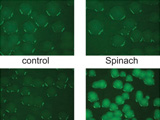|
|
TODAY.AZ / Weird / Interesting
New fluorescent 'spinach' molecule illuminates inner workings of RNA
31 July 2011 [11:24] - TODAY.AZ
 The newest optical techniques are making cell biology a little clearer, but it’s still a murky business, watching cells work. A new technique that illuminates RNA — the builder of proteins, making copies according to DNA’s blueprint — is one way to shine a light on that process.
The newest optical techniques are making cell biology a little clearer, but it’s still a murky business, watching cells work. A new technique that illuminates RNA — the builder of proteins, making copies according to DNA’s blueprint — is one way to shine a light on that process. 
Spinach RNA Images of Spinach RNA expressed in E. coli. Colonies expressing the control molecule exhibited no fluorescence, but colonies expressing the Spinach molecule were brightly fluorescent. Paige et. al/© Science/AAAS
Researchers have been using green fluorescent protein for years, tagging molecules and cells to make them glow under certain conditions and when certain changes occur. Now scientists at Weill Cornell Medical School in New York have figured out how to make RNA molecules light up, so they can watch them at work.
Monitoring RNA could help biologists understand how and when the molecules move around in cells, in response to which signals. This could help answer questions about gene expression and about viruses, which use RNA instead of DNA as their genetic material.
Jeremy Paige and colleagues at Weill Cornell worked with derivatives of the green fluorescent protein molecule, called fluorophores, which are what make the molecule glow in certain light wavelengths. They looked for short RNA molecules that could bind to them, the team explains in a paper published today in Science.
They found a host of combinations across the visible spectrum, but just like with jellyfish protein, green was the best. A combination of RNA and fluorophore complexes nicknamed Spinach is just as bright as GFP, the researchers say. What’s more, it doesn’t bleach under microscopic light, and it makes molecules glow faster than regular GFP. They tested it with E. coli and watched bacterial colonies light up.
The method could be a simpler way to tag RNAs for a wide range of applications, the researchers say.

Monitoring RNA could help biologists understand how and when the molecules move around in cells, in response to which signals. This could help answer questions about gene expression and about viruses, which use RNA instead of DNA as their genetic material.
Jeremy Paige and colleagues at Weill Cornell worked with derivatives of the green fluorescent protein molecule, called fluorophores, which are what make the molecule glow in certain light wavelengths. They looked for short RNA molecules that could bind to them, the team explains in a paper published today in Science.
They found a host of combinations across the visible spectrum, but just like with jellyfish protein, green was the best. A combination of RNA and fluorophore complexes nicknamed Spinach is just as bright as GFP, the researchers say. What’s more, it doesn’t bleach under microscopic light, and it makes molecules glow faster than regular GFP. They tested it with E. coli and watched bacterial colonies light up.
The method could be a simpler way to tag RNAs for a wide range of applications, the researchers say.

Green Fluorescent RNA: Control E. coli is on the top left, and E. coli with RNA-fluorophore complex at bottom left. Paige et. al/© Science/AAAS
/Popular Science/
/Popular Science/
URL: http://www.today.az/news/interesting/91776.html
 Print version
Print version
Views: 2129
Connect with us. Get latest news and updates.
See Also
- 06 December 2024 [22:20]
Are scented candles harmful to health? - 23 November 2024 [14:11]
Magnitude 4.5 earthquake hits Azerbaijan's Lachin - 20 November 2024 [23:30]
Launch vehicle with prototype of Starship made its sixth test flight - 27 October 2024 [09:00]
Fuel prices expected to rise in Sweden - 24 October 2024 [19:14]
Turkiye strikes terror targets in Iraq and Syria - 23 October 2024 [23:46]
Kazakhstan supplied almost entire volume of oil planned for 2024 to Germany in 9 months - 23 October 2024 [22:17]
Taiwan reported passage of Chinese Navy aircraft carrier near island - 23 October 2024 [21:50]
Russia remains largest oil supplier to India - 16 October 2024 [17:54]
Gamesummit co-founder shares insights on future of gaming industry in Azerbaijan [EXCLUSIVE] - 12 October 2024 [18:27]
TikTok cuts jobs, turns to AI for content moderation
Most Popular
 Azerbaijan, Colombia Discuss Cooperation in Various Fields
Azerbaijan, Colombia Discuss Cooperation in Various Fields
 Armenian militant group threatens regional stability aligning with PKK/YPG in new ground
Armenian militant group threatens regional stability aligning with PKK/YPG in new ground
 Lapshin shows up, again collecting alms from naive Armenians
Lapshin shows up, again collecting alms from naive Armenians
 Rubik Vardanyan surprises his own lawyers
Rubik Vardanyan surprises his own lawyers
 Azerbaijan and Qatar strengthen environmental cooperation, says Minister
Azerbaijan and Qatar strengthen environmental cooperation, says Minister
 Armenian History in Crisis: Mirzoyan, Textbook and Colosseum
Armenian History in Crisis: Mirzoyan, Textbook and Colosseum
 Azerbaijani and Turkish parliament speakers meet in Ankara
Azerbaijani and Turkish parliament speakers meet in Ankara
